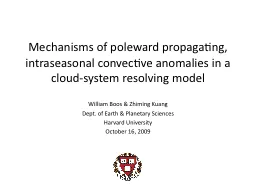

intraseasonal convective anomalies in a cloudsystem resolving model William Boos amp Zhiming Kuang Dept of Earth amp Planetary Sciences Harvard University October 16 2009 Outline Background and observations ID: 227684
Download Presentation The PPT/PDF document "Mechanisms of poleward propagating," is the property of its rightful owner. Permission is granted to download and print the materials on this web site for personal, non-commercial use only, and to display it on your personal computer provided you do not modify the materials and that you retain all copyright notices contained in the materials. By downloading content from our website, you accept the terms of this agreement.
Slide1
Mechanisms of poleward propagating, intraseasonal convective anomalies in a cloud-system resolving model
William Boos & Zhiming KuangDept. of Earth & Planetary SciencesHarvard UniversityOctober 16, 2009Slide2
Outline
Background and observationsResults from quasi-2D models with explicit convectionMechanisms of instability and propagationMain message:For intraseasonal convective anomalies during boreal summer: Poleward propagation occurs due to convectively-coupled beta-drift of a vorticity strip Instability occurs due to moisture-radiation feedbackSlide3
Borealsummer MJO lifecycle of TRMM precip
diagnostic from CLIVAR MJO working group, based on EOFs after Wheeler & Hendon (2004)propagation has prominent poleward component some events do exhibit poleward propagation without eastward propagationSlide4
Viewed as poleward migration of ITCZ
1.5 m/s
NOAA OLR anomalies, 80-100°E, summer 2001
Several events typically occur each boreal summer, modulating intensity of South Asian monsoon Slide5
History of axisymmetric model studies
Land-atmosphere interactions (Webster & Chou 1980)Poleward gradient of convective instability (Gadgil & Srinivasan 1990)Dynamical coupling of anomalies to baroclinic mean state (Bellon & Sobel 2008, Jiang et al. 2004)… but all of these studies use idealized parameterizations of moist convection, and mode characteristics depend on convective closureSlide6
Test in model with explicit convection
System for Atmospheric Modeling (SAM, Khairoutdinov & Randall 2003)1 km horizontal resolutionBeta-plane, 70°N – 70°S4 zonal grid pointsOceanic lower boundary with prescribed SST
precipitationSlide7
Model with wider zonal dimension
4 zonal grid points32 zonal grid pointsPrecipitation snapshots when ITCZ is near 10N:
60
40
20
0
-20
-40
-60
latitude
60
40
20
0
-20
-40
-60
Old domain:
140° meridional x
4 km zonal
New domain:
140° meridional x
960 km zonal
For computational efficiency, use RAVE methodology of
Kuang, Blossey & Bretherton (2005)
:
30 km horizontal resolution, RAVE factor 15
Similar results obtained for RAVE factors ranging from 1-15 at 30 km resolution, and for one standard run with 5 km resolution
x (km)
x (km)
mm/day
0 500 960Slide8
Precipitation in wide-domain model
0.5 m/smm/daySlide9
Zonal mean
vertical structure for wide domainm/sm/sm/sSlide10
Composite 950 hPa vorticity
Zonal mean vorticity satisfies necessary condition for barotropic instabilityAnomalies form closed cyclone for part of poleward migration, and zonal strip for remainderSuggestive of “ITCZ breakdown” (Ferreira & Schubert 1997)
zonal mean vorticity
composite
relative vorticity
latitudeSlide11
Animation of two events
Poleward drift of vorticity patch/strip on β-plane… coupled to moist convectionlatitudex grid pointShading: 930 hPa relative vorticityBlack contours: precipitationSlide12
Schematic: propagation mechanism
deep ascent creates (barotropically unstable) low-level vortex strip3. Ekman pumping in vortex strip humidifies free-troposphere poleward of original deep ascent, shifting convection polewardConvectively-coupled beta-drift of vortex strip
deep ascent
2. perturbed vortex strip migrates poleward
deep ascent
vorticity anomaly
x
y
vorticity anomaly
y
zSlide13
Test mechanism in dry model
β-drift biases low-level convergence poleward of free-tropospheric heating
applied (constant) thermal forcing
surface meridional windSlide14
Surface wind in dry model
latitudeconstant imposed heatingx grid pointSlide15
Looks like unstable moisture mode
J/kgMSE tendencies
composite moist static energy anomalySlide16
Model tests of instability mechanism
mm/day
fixed radiative cooling
fixed surface heat fluxes
control run
Precipitation Hovmollers:Slide17
Instability mechanism is non-unique
Dashed black lines denote latitude of peak moist static energy anomaly
Control run
Run with fixed radiative coolingSlide18
Summary
Axisymmetric cloud permitting models fail to produce robust poleward propagating, intraseasonal convective anomaliesMeridional “bowling alley” domains O(1000 km) wide do produce such anomaliesSuggested propagation mechanism: convectively-coupled beta-drift of vortex stripAnomalies destabilized by moisture-radiation feedbackPerhaps slowed and made more coherent by WISHEMultiple instability mechanisms can operate, with structural changesFuture work:Behavior in wider domainsValidation of mechanism in simpler modelsSlide19
Additional slidesSlide20
Wide domain permits high amplitude eddies
latitude
x (10
5
m)
g/kg
day 0
day 20
day 30
day 41
day 53
composite 930 hPa wind and humiditySlide21
Why does the wide domain make a difference? It’s the eddies…
J/kgMSE tendencies
composite moist static energy anomaly
advective components
total & zonal mean advectionSlide22
Propagation speed scalingPlots of precip and v wind for beta 0.75, 1, 2Slide23
Observed vertical structure
data: ERA-40 Reanalysis, composite of strong poleward events 1979-2002latitude
pressure (hPa)
Note some similarties to eastward moving MJOSlide24
latitude
pressure (hPa)
Observed vertical structure
data: ERA-40 Reanalysis, composite of strong poleward events 1979-2002Slide25
Behavior depends on zonal width,not zonal d.o.f.
time (days)latitudelatitude
5 km resolution with 32 zonal grid points
30 km resolution with 32 zonal grid pointsSlide26
OLR in wide domain modelSlide27Slide28
Vertical structure for wide domain
(green line denotes position of peak precip signal used for compositing)m/sSlide29
Turn off both WISHE & radiative feedbacks
no WISHE or radiative feedbacks
control
time (days)
mm/day
Precipitation:Slide30
MSE budget for run without WISHE or radiative feedbacks
moist static energy anomalylatitude (degrees)
pressure (hPa)
moist static energy tendencies
W m
-2
“Convective downdraft instability”
J/kg